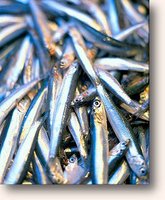
Wait a minute, just had a thought. My Italian ancestors must have been involved in the anchovy industry since the image of a fishing net keeps popping into my mind. Why do I think this? I don't know.
Anchovy
From Wikipedia, the free encyclopedia.
The anchovies are a family (Engraulidae) of small but common schooling saltwater plankton-feeding fish. They are found in scattered areas the throughout the world's oceans, but are concentrated in temperate waters, and rare or absent in very cold or very warm seas.
Biology
The anchovy is a small green fish with blue reflections dorsal to a silver longitudinal stripe that runs from the base of the caudal fin. It is a maximum nine inches in length and body shape is variable with more slender fish in northern populations. The snout is blunt with small, sharp teeth in both jaws. The mouth is larger than those of herrings and silversides, two fish which they closely resemble. It eats plankton and fish larvae.
It is generally very accepting of a wide range of temperatures and salinity.Large schools can be found in shallow, brackish areas with muddy bottoms, as in estuaries and bays.
Spawning occurs between October and March, but not in water colder than 54 degrees Fahrenheit (12 degrees Celsius). The anchovy appears to spawn 100 kilometers from the shore, near the surface of the water.
As a food source
The anchovy is a food source for almost every predatory fish in its environment, including the California halibut, rock fish, yellow tail tuna, sharks, chinook, and coho salmon. It is also extremely important to marine mammals and birds; for example, California brown pelicans and elegant terns, whose breeding success is strongly connected to anchovy abundance.
They are also eaten by humans. Anchovies preserved by gutting and salting in brine, matured, then packed in oil, are an important food fish, both popular and unpopular for their strong flavor. In Roman times, they were the base for the fermented fish sauce called garum that was a staple of cuisine and an item of long-distance commerce produced in industrial quantities. Today they are a key ingredient in Caesar salad and Spaghetti alla Puttanesca, and are occasionally used as a pizza topping. Because of the strong flavor they are also an ingredient in several sauces, including Worcestershire sauce and many other fish sauces, and in some versions of Café de Paris butter. Fishermen also use anchovies as bait for larger fish such as tuna and sea bass.
The strong taste that people associate with anchovies is due to the curing process. Fresh anchovies, known in Italy as alici, have a much softer and gentler flavor. In English-speaking countries, alici are sometimes called "white anchovies", and are often served in a weak vinegar marinade.
European anchovy Engraulis encrasicolus is the anchovy of commerce. Morocco now leads the world in canned anchovies. The anchovy industry along the coast of Cantabria now dwarfs the traditional Catalan salters, though the industry was only initiated in Cantabria by Sicilian salters in the mid 19th century.
Fishing
Overfishing of anchovies has been a problem. Since the 1980s, large mechanized anchovy fishing vessels based in France have caught the fish in fine-mesh dragnets.

No comments:
Post a Comment